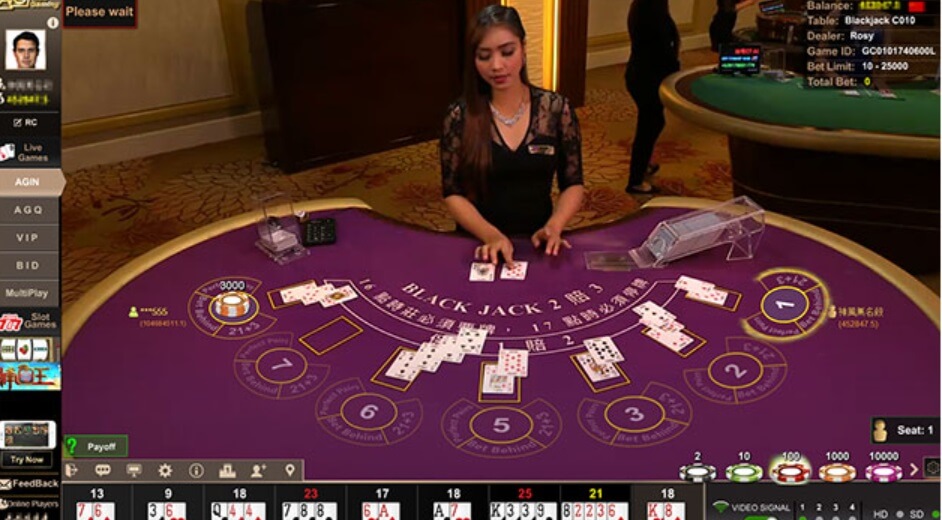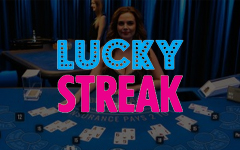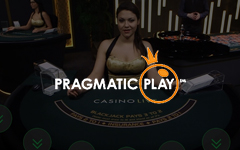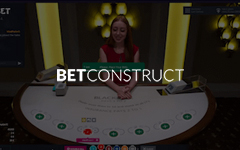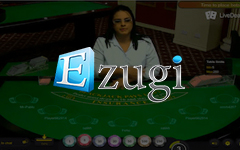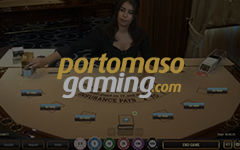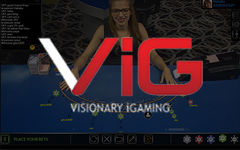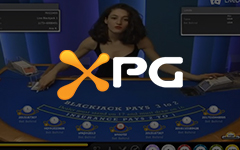Providers
Live dealer providers are the ones that are largely resposnible for what your playing experience will be like. It’s guite exciting to see them improve at such rapid place, since live dealer online casinos are a relatively new concept that only started gaining popularity after 2008. Below we’ll provide some thoughts on companies that offer live blackjack.
Live Blackjack Provider Comparison
Evolution
The current live dealer casino industry leader – and that applies to blackjack too. EVO provides an outstanding stream quality on all devices from the latest iPhone to a budget Android tablet. They also have presentation and table variety like no other company. To our knowledge, they currently have studios located across the world including Latvia, Malta, Georgia and Canada. Evolution are... also known to collaborate with big operators to create branded studios with completely customised environments and game mechanics – just like they recently did with Casumo. It’s also worth pointing out that their blackjack is available with live dealers speaking English, Swedish (Unibet), Russian (Marathonbet), German ( Mr.Green), Danish (Leo Vegas) and Italian (Leo Vegas). Their house rules are fair and in line with industry standards. When played with basic strategy, Evolution Gaming live blackjack has an RTP of 99.28% (according to them). You can also place side-bets, of perfect Pairs and 21+3, on almost any EVO table.
NetEnt
This developer is mainly known for their success in the online slots industry, but they are also a very solid live casino provider. Their blackjack includes tables come in VIP Highroller, Common Draw (Unlimited) and regular varieties. It’s worth pointing out that NetEnt’s live blackjack is dealt out of a shoe consisting of 6 decks of cards, whereas most of the competition use 8 decks. This coul...d be quite favourable if you’d like to try your hand at card counting. NetEnt’s stream quality is consistently equal to that of top-tier providers like PlayTech and Evolution Gaming.
Lucky Streak
This is a smaller developer based in Latvia offering just a handful of live blackjack tables and not currently operating in the UK. We still thoroughly enjoyed their live blackjack, which offers a user-friendly environment and an easy to navigate casino platform. Their live dealers are also well trained, speak fluent English and are professional and courteous at all times. Lucky Streak does not... claim to have multi-lingual tables, but their dealers do often speak English, Russian, Latvian and sometimes Spanish.
The option to bet behind is also available and so are Perfect Pairs & 21+3 side bets. You can also tip the dealers.
PlayTech
Quality and reach wise Playtech is one of the only real competitors to Evolution Gaming. Their product is top quality across all devices too, but they don’t have as many tables as EVO. However, the majority of the time you will only find PlayTech live casino games at sites that use their full integrated platform – such as BGO, William Hill and Paddy Power. So, this makes it rare to see a ...small or medium sized online casino that has PlayTech live dealer games on offer.
Playtech recently built a major studio in Riga, Latvia, in order to keep up with demand and offer more variety when it comes to tables. When we tested what they had to offer at BGO Live Casino, they had 22 open tables for blackjack. That’s pretty impressive, by anyone’s standards!
Pragmatic
Rebranded from Extreme Live Gaming after it was acquired is a small-scale operation with just a couple of live blackjack tables available. They offer a few different playing environments – namely regular, VIP and Italian speaking dealer tables. They offer both bet behind and the standard side bets (Perfect Pairs & 21+3), but the surrender option is not offered at any of their tables.... The streaming quality is consistent, but definitely a tier lower than Evolution and PlayTech. You might not be able to play Pragmatic Play tables at many top tier live casinos, but you will find them at Leo Vegas.
Betconstruct
Is a major player in the gaming platform and sports betting space, but they are also a live casino developer too. We were pleasantly surprised at the quality and variety of their live blackjack tables. We found 13 tables on offer with dealers speaking English, Turkish, Persian, Russian, Armenian and Arabic. This is a lot of languages, suitable for live blackjack fans all over the world, and inc...ludes some you won’t find anywhere else. More so, the tables look great and the streaming quality is excellent. BetConstruct’s live blackjack is also the only one we have seen offering their unique Honey Bonus and Lucky Sevens side-bets. Their live studio is located in Yerevan, Armenia.
Ezugi
May have made headlines as the first provider to supply live dealer games to a regulated US online gambling market in New Jersey, but they have a long history of operating in different markets before that. They run a pretty sophisticated live dealer platform with studios in multiple locations – Latvia, Romania and Costa Rica. This lets them tailor their service to players from different locatio...ns, while also offering some tables in languages other than English. Turkish and Spanish speaking customers can play at separate blackjack tables from Ezugi, while most of their Latvian dealers also speak Russian. Blackjack variety wise, you’ll find regular tables where 21+3 and Perfect Pairs side bets are offered as well as an Unlimited Blackjack table, where a seat will always be available. At the time when we tested their games at Jetbull Casino, there were 12 live blackjack tables open. However, you can expect this to increase at peak hours.
Vivo
Are mainly focused on Spanish speaking markets, but their tables are also offered in English. The stream quality is acceptable, but definitely not yet comparable to top-tier providers. We’d speculate that Vivo Gaming has most of their customers coming from markets like Spain, where they are one of the few providers offering live dealer games. Apart from the quality and mediocre UI, Vivo Gaming’...s blackjack features eight decks and seven players. You can double down on any two cards and split up to two hands.
Portomaso
The Portomaso brand is associated with multiple land-based casinos in Malta, which is actually where most of their games are streamed from. To our knowledge, they are the only provider that actually stream live blackjack from a land-based casino. In this case, streamed from the Oracle Casino in St Paul’s Bay. We enjoyed using the user interface of their platform, especially on desktop. However,... the fact that they are one of the few (so far, the only one that comes to mind) live blackjack developers that let you split multiple times – up to four hands in this case. Generally, at most live online blackjack tables you can split only once. So you can see why this is a neat feature, although the table can get a little messy if multiple players take advantage of this rule – especially on mobile. Portomaso currently offers 3 tables to choose from and all of these come with Perfect Pairs & 21+3 side bets. You can place these after sitting down at the table.
VIG
Visionary iGaming seem to be focused towards customers in the USA, as well as some European markets such as Spain, France and Italy. Their studios are located in San Jose, Costa Rica, thus making all dealers fluent in English and Spanish. We found four tables operational that had a decent, albeit not great, stream quality. Your experience may be disrupted by overly loud background noise and occ...asionally unclear card information, especially on a smaller mobile screen. Overall VIG’s offering is comparable to Vivo Gaming in terms of stream and UI quality. The big difference in terms of drawing rules here is that the dealer hits soft 17 and you can surrender at any time – as long as the dealer does not have blackjack. This gives it a slightly superior RTP to many other live blackjack games. VIG Blackjack is playable at Bovada Casino (for US customers) and MYB Casino (worldwide).
XPRO
This live dealer software provider used to target the Asian market, but they’ve recently started making moves in the European market too. The biggest selling point to games from this company is the fact that they offer unique side bets, plus you’ll also find that it’s possible to claim multiple seats. There are, unfortunately, some problems though, which is why XPRO Gaming haven’t become one of... the bigger live casino names. These problems include a poor user interface, as well as the fact that not all hands hitting blackjack pay out at 3:2. There are two different types of blackjack offered by this software provider: standard blackjack and unlimited blackjack.
HoGaming
HoGaming has been in the casino industry for decades and are based in the gambling hub that is Macau. They only offer one live blackjack table, however it’s a really good one. The biggest feature is the fact that players can bet behind, giving all the chance to bet even when there’s no space to sit down. The rules at the live blackjack table are pretty standard, so most players will be able to ...get into the swing of things straightaway. The house edge is 0.61%, which is about average for live blackjack games. Players can take a maximum of three seats per table. HoGaming certainly isn’t the largest name in the live casino world, however their product is a strong one, giving everyone a no-nonsense version of live blackjack to enjoy.
Medialive Casino
Those in Italy might be aware of this live casino company, however it’s not a big name outside of the country. Despite being formed in 2005, they haven’t managed to spread their name around the blackjack community, although this is partly thanks to the fact that they usually make white label games. All games are broadcast from Malta and there’s just one version of blackjack. You can play in two... different views though, plus you can also play a maximum of three hands at once. The house edge of 0.73% isn’t awful, although there are better house edges available elsewhere. You won’t find any side bets when you play Medialive blackjack, however there are some purists who will be glad they can focus on the main game.
EntwineTech
There are some big live dealer software companies in Asia, and one of the largest of them is EntwineTech. They offer a large range of different games, including a simple version of blackjack. This game can be played by mobile users, as well as those sitting in front of a desktop. There are many advantages to playing this game, however the biggest is the intuitive gameplay. Players will also fin...d that the live stream is incredibly high quality, plus the Pairs side bet option is often used by those looking to up the level of excitement. This company currently works mainly within the Asian market, however they are expected to start targeting the European market very soon.
Gameplay Interactive
Gameplay Interactive doesn’t focus on live blackjack, but it does offer one simple version of the game to live casino players. This version of the game offers intuitive gameplay and a single side bet, plus there are no strange rules to learn before playing. The live games from this company are generally focused on the Asian gambling market, however there are English-speaking games on offer. Mos...t of the dealers are from the Philippines, which is common with Asian live casino companies. We’ve found that the house edge at this game is a fair one, therefore meaning that players have a decent chance of winning money while they play.
Asia
Asia Gaming is a name more commonly associated with gambling in China, however they’re now starting to turn their attention towards the European market. They only offer a single version of live blackjack, however it’s a good one, available in HD to both desktop and mobile players. You don’t need to learn anything new to play the game from this company, as the rules are standard. The house edge ...of 0.62% is also reasonable, giving everyone a decent chance of winning some money when they play. Asia Gaming certainly isn’t the biggest live casino company at the moment, but if their expansion into Europe goes well, they should become a name every gambler has heard of.
BBIN
BBIN is a huge name in the Asian gambling world, however it’s basically unheard of in Europe and North America. Their version of live blackjack is one based on Unlimited Blackjack, so you’ll always be able to get a seat, and you should find that the house edge is a fair one. The gameplay is exceptionally simple, and enjoyment is enhanced by the multiple camera angles. The dealers are generally ...good, and mostly come from the Philippines. It’s possible to play BBIN live blackjack in English or Chinese. If you enjoy live blackjack, we’d definitely recommend playing the version offered by this company, as it’s intuitive, slick and loads of fun.
Commonly Used Blackjack Terms
When it comes to gambling, it takes much more than just a huge desire to play a game and a fine amount of money in the pockets. Before a player sits at the table, a real or digital one, an essential step to take is acquiring a thorough knowledge of the rules and strategies, as well as basic terminology.
Our list here gives an insightful retrospective of the most commonly used terms in Blackjack, heard in both land-based and online casinos. Keep reading to find out more about house edge, side bets, shoe penetration, and other important expressions.
 House Edge
House Edge
In BJ the house edge (HE) represents the statistical advantage the casino has over the player. A representative playing on the behalf of the venue is the dealer, and he/she gains the advantage over the other participants by observing their cards, actions, and catching potential mistakes.
The HE percentage in BJ is 0.5%, but only in a situation where punters are effectively implementing basic strategy. However, how well a strategy is executed will determine the precise percentage, but a specific variant of the game will also have an impact on the edge.
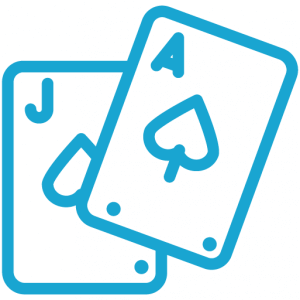 Decks Used
Decks Used
Outside the casino, this game can be played with as little as one or two decks. On the other hand, when played on the casino floor (be it land-based or digital), around six to eight decks are used. For a game of BJ, an international 52-card deck is utilized, without jokers.
The number of decks is of particular interest to players who like to implement card counting techniques. As the number of decks increases, it becomes more challenging to count, meaning- no strategies can be used, playing by the rules is the only option. The less the decks, the more advantageous situation for the punter it is.
 Surrender
Surrender
Surrender in BJ is a strategy in which the punter may fold the hand risking only half of the bet rather than the entire amount. There are two different types of BJ surrender- Early and Late. Early Surrender is done before the dealer checks for blackjack, while Late Surrender is done after that. A game that offers surrender has a HE .08% lower than the one where similar rules are used but no surrender is offered.
A player’s decision to (or not to) surrender depends on whether the dealer hits or stands on soft 17. There are seven times a player should surrender when the dealer hits a soft 17, and only four in case the dealer stands on soft 17.
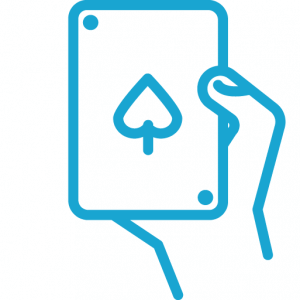 Dealer Hits Soft 17
Dealer Hits Soft 17
First of all, we need to define what soft 17 represents. Any hand that features an ace valued at 11 is called a soft hand. So, there are several possible combinations such as an ace and six, or an ace in combination with two 3s.
When a hand has no aces or has one or more but they count as one, it’s called a hard hand, such as 10-7, ace-7-9. Soft and had hands are not played in the same way- soft ones should never stand, while the hard ones should always stay. However, each hub determines what a dealer will do in this situation, meaning whether he/she “must stand on all 17s” or “hit soft 17”. When this rule is in effect, it favors the casino, as it reduces punter’s net expectations by 0.20%.
When the dealer hits a soft 17, punters will surrender 15 and 17 against an ace. A pair of 8’s is split against every hand except for when the dealer has an ace, in which case, it should be surrendered.
In the other scenario, when the dealer stands on all 17’s, players should surrender 16 against a 9, 10, or an ace. The exception is a pair of 8’s, which are never surrendered. They should be split against any dealer door card. In a situation when there’s a dealer’s 10-value card versus a 15 hand, the latter one should be surrendered.
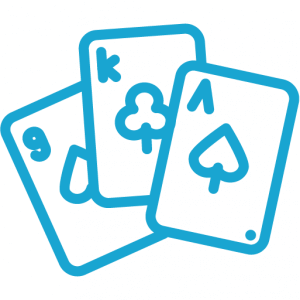 Double On Any Two
Double On Any Two
When a player doubles his/her bet in the middle of a hand and receives one more card after that- this is called Double on Any Two or Double Down. This move is both profitable and risky because if a player is dealt a low card, he/she cannot hit again. For that reason, a player needs to learn in which situations it is smart to make this move, and in which ones to avoid it.
Placing this type of bet is recommended in the following three scenarios- when a player’s cards total 11, when and a player has soft 16, 17 and 18, and when a player has a hard 9 or 10. As for “when not to”, it’s the situation when the dealer is showing an ace, and when a player is showing anything higher than an 11.
Although particular situations may not always be favorable towards a punter, this tactic can increase the winning in the long run, if properly implemented. It should, by no means be utilized all the time with all hands, as it leads to a significant loss. Only when a punter is a clear frontrunner, as implied in these three scenarios, Doubling Down makes sense.
 Double After Split
Double After Split
Double Down After Split (DDAS) is believed to be one of the best options for players. It represents the following scenario- when a player is dealt a pair and then decides to split it, and when again dealt to those split cards he/she can place an additional wager, equal to the original, and double the stakes on whichever half of the split.
The majority of casinos nowadays allow Doubling Down on any two original cards, and most of them also allow Doubling Down after splitting. It’s very important to check out the specific set of rules for each venue before sitting at the table- a player should never feel uncomfortable inquiring about the rules before the game.
 Re-Split Rules
Re-Split Rules
Analyzing the rules venues-wide, a player can notice that some of them even allow for re-splitting not only for 2 or 3 hands but until the player has as many as four hands. Moreover, some rules allow doubling the bet after a split. This way each hand has a bet double the original.
When it comes to specific cards, aces and eights are the ones that split, while tens, fours, and fives should never be split- these are some general recommendations. In addition to this, there are situations when splitting depends on the dealer’s up card. Again, each player should check the rules before the game begins.
 Hit Split Aces
Hit Split Aces
When aces are not split, one of them values as 1 while the other counts as 11. For that reason, splitting a pair of aces is a move that makes sense, as there are many cards with a value of ten.
In case they remain unsplit, only a nine as the next card can result in 21. Also, players should know that after splitting aces, one is not permitted to hit more than once.
One of the main reasons why most hubs don’t allow this is that it reduces the HE by 0.19%. Also, when this is permitted, it boosts the variance- one of the most illustrative examples would be four aces in a row, split in four hands, with the ability to hit and/or double down.
 Insurance Pays
Insurance Pays
The Insurance bet is a side bet offered in the situation when the dealer has an ace as the up card. A player is then allowed to bet half of the original wager and it pays 2 to 1. In case the dealer’s second card is a ten, J, Q, or K, a dealer makes blackjacks, meaning- the Insurance bet wins.
In real life, this is not a desirable bet to place, as it is a losing proportion. Moreover, the odds depend on the number of decks being used in the game and the number of ten-point cards that have already been dealt. For example, for a one-deck game is 5.8%, while with eight decks it increases up to 7.5%.
For that reason, this bet makes sense only if a player is an advanced card counter and knows how many ten-point cards are still left in the deck. Also, this rule applies to pro-level punters in brick and mortar casinos, not in online hubs.
 Blackjack Pays
Blackjack Pays
This is one of the crucial things to pay attention to, as the payout percentage determines whether a table is worth sitting at or not. Casinos-wide, one may spot 3:2 as the most common ratio, while there are those offering 6:5 games on single decks or low limit games.
Expressed in money, the situation would look like this- in 3:2, for every 2 dollars placed, a player would get paid 3 dollars (1.5:1 odds), for a winning blackjack hand. In 6:5, for every 5 dollars placed, a punter is paid 6 dollars (1.2:1 odds).
 Dealer Peeks for BJ
Dealer Peeks for BJ
When a dealer checks to see if he/she has Blackjack before the players start taking hits, this rule is called Peek or Dealer Peek. In case a dealer doesn’t check for blackjack if the up card is an ace or ten, it is called No Peek. On the other hand, Full No Peek means that the dealer will not check for Blackjack until all punters have taken their turn, regardless of the dealer’s up card.
Dealer Peeks is a fine rule from the player’s perspective, as it prevents him/ her from splitting and doubling down, increasing your bet only to find the dealer has Blackjack. In most establishments, the dealer can pay or take an insurance bet immediately after a peek at the down card, while in others, the payoff waits until the end of the play.
 Bet Behind
Bet Behind
This possibility allows punters to place a bet on another player’s hand, in both situations- when they are already participating in the game and when they are waiting. Even though this used to be an option exclusively reserved for brick and mortar facilities, it can be found in online hubs as well.
Some players like this option because it allows them to play even when all seats are occupied, or get more action if they are already in the game, placing a bet Behind on some other player. The opponents of this option say the biggest downfall is that the one betting behind cannot make strategy decisions and is “at the mercy of the player”.
 Multi-Seat
Multi-Seat
The number of seats differs from venue to venue, but in online parlors, a provider also plays a significant role in determining how many players will be allowed per table. Some of them have 7 seats and also allow Bet Behind which creates massive multi-player scalability. The newest achievement in the field sees “infinite” tables, meaning an unlimited number of participants can play.
There are three different seating positions- First base, Third base, and Shortstop position. From the dealer’s perspective, the First is the one on the far left, while the Third represents the far right (the anchor). Shortstop is the one in the middle.
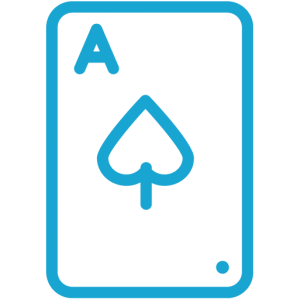 Shoe Penetration
Shoe Penetration
Also known as deck penetration, the term refers to the percentage of cards that have been dealt before the dealer reshuffles the cards. Let’s take a single-deck of 52 cards as an example-if 34 cards have already been dealt, it means the shoe/deck penetration is 65%.
This is not as important to punters implementing basic strategies, however, it is of vital importance to card counters. The larger the shoe penetration, the situation is more favorable for the player, as it means more cards are dealt and “counted”, so the counting of the remaining part will be more accurate.
For this reason, the majority of venues will limit card counting and hence deck penetration by reshuffling when one or more decks remain undealt- this goes for id=”shoe_penetration”multi-hand variants.
 Multi-Table
Multi-Table
As assumed from the name, this option allows one to play multiple tables at the same time. Whether permitted or not, each player should have a thorough knowledge of optimal strategies for a single table before he/she proceeds to playing on two or more simultaneously.
After mastering the skills and decision-making process on one table, a punter should then try two, then three, etc. Also, if one is interested in multi-tabling, a big bankroll is a must as well.
 21+3 Side Bet
21+3 Side Bet
This is a type of side bet in BJ, based on the first two cards dealt to the player and the dealer’s face card. A player wins if the combination of these cards is some of the following: Suited trips (for example Q of Diamonds), Straight Flush (such as J, Q, and K of Diamonds), then Three of a Kind (J of Diamonds, J of Clubs and J of Hearts, for example), Straight (such as 6 of Diamonds, 7 of Clubs, and 8 of Hearts), as well as Flush (e.g. J, K, and Ace of Diamonds).
The odds significantly vary from one venue to another, and before deciding whether to place it or not, players must familiarize themself with the odds. Generally speaking, all the side bets are seen as sucker bets, with one minor exception- when a player is an experienced card counter. The edge depends on the number of decks and it can even go up to 13.39%.
 Perfect Pairs Side Bet
Perfect Pairs Side Bet
The beginning of looks the same as in the standard game- both player and the dealer get two cards, but the side bet is different. In case one gets perfect pairs, one wins, but it also depends on how good a pair is.
Here are the possible combinations: different colors and different suits, same color but different suits and same color and same suit (the eponymous perfect pair). Keep in mind that the payout for each of them varies from one facility to another, which dictates whether one should or should not play it. The payout ranges between 2% and 11%.
 Honey Bonus Side Bet
Honey Bonus Side Bet
This type of side bets can be seen in venues powered by BetConstruct. In this one, wins are usually based on the punter’s initial two cards and the dealer’s up card. Here, a player bets on his/her and the dealer’s hands to make a poker style hand.
Those are the following: a three-of-a-kind (20:1), a straight (10:1), and a flush (5:1). The one exclusively added here is the suited blackjack bet, and what makes it particularly interesting is that it pays out 3:1 on top of a normal pay-out for a blackjack. In terms of HE, it can go as high as 15%.
 Lucky7s Side Bet
Lucky7s Side Bet
One more type of side bet commonly seen in BetConstruct-equipped facilities, and it comes with the following payout: One 7 pays out 3:1, a pair of 7s (different suits) 25:1, a pair of suited sevens – 50:1, then three unsuited sevens – 100:1 and three suited sevens 500:1.
Overall, they don’t come with good RTP, and they are usually avoided by experienced players. Expressed in percentage, this bet comes with 50% HE.
FAQ About Live Blackjack
Absolutely, and there are many live blackjack apps to use on your mobile.
Our personal favourite is the Leo Vegas app, where you can actually see if a table has any seats available before you join. Weirdly enough, when using most other apps you cannot see this information.
Leo Vegas also have their own private studios with multiple Leo branded blackjack tables and a generous signup bonus. They also organize exclusive promotions for live dealer players on a fairly consistent basis.
Most bonuses cannot be used at live casino games, but there are sites out there that choose to focus on live dealer players. These live casino sites will regularly offer tailored deals for live blackjack.
One such casino is Leo Vegas, where players are offered a 100% deposit match up to £/€250. The wagering requirement on this is 70x – but live blackjack counts for 100% of the wagers made on it.
We’d like to add that the minimum deposit to claim this offer is £/€20 (or currency equivalent) and it is available for players in the UK, Canada, Germany, Austria, Switzerland, Finland, Sweden, Norway and New Zealand. 100% of your live blackjack bets counting towards your playthrough requirement is actually a very rare offer, and one blackjack fans should definitely consider carefully.
If you are concerned about the house edge in blackjack, then no. Side-bets like Perfect Pairs and 21+3 have a house edge of around 4-5% making them much worse than simply making the main bets.
However we do get the appeal, as side-bets often offer much higher payouts in terms of the bet multiplier.
Yes, but only in a few countries. You can use PayPal in the UK, Denmark, Spain, Germany and Sweden – at the moment. New countries are added to this list from time to time, so keep an eye out.
The next step is to find a casino that actually accepts both PayPal deposits and players from your country of residence.
UK players can deposit with PayPal at William Hill, while other European customers should be able to use 888 Casino and Party Casino.
Yes. Unibet and Betsson Live Casino both have live blackjack in Swedish. Note that both of these are private tables offered in collaboration with Evolution Gaming. The tables seem to be operational daily from 14:00 GMT.
Unibet Live Casino has the highest blackjack limits we have found. You can stake up to £/€50k per box and play up to 3 boxes. The tables for this are Unibet’s private VIP live blackjack from Evolution Gaming.
For USA players the top choice is Bovada where you can bet up to $10k per box on their VIG Live Blackjack tables.
Unlimited Blackjack is a variation that lets an unlimited number of players play the same hand. We’ve seen this offered by NetEnt, PlayTech and Ezugi. Evolution Gaming also launched their own version in late 2018, known as Infinite Blackjack.
The game plays on more of an autopilot mode than your usual blackjack table, as all pairs are automatically split according to basic strategy. However, players can still choose when to hit or stand.
We’d recommend familiarizing yourself with the exact rules of the game you are in before playing – which you can do by using the help section of the provided user interface.
This entirely depends on the casino site you play at. We track limits on some of the live blackjack tables, and these go as low as £0.20 if you are willing to play on the “bet behind”.
BGO has a low £2 minimum bet on their private table from PlayTech. Other than that, most Evolution Gaming powered casinos let you bet £0.50 on their Blackjack Party tables.
Yes, you most definitely can. VIG (Visionary iGaming) offer their live blackjack at a number of casino brands that accept players from the US. The two casinos we can recommend are MYB Casino and Bovada. The latter recently added live dealer games, and they also offer sports betting and online poker.
Funding your account is easy and can be done with all major credit/debit cards. Recently, many US facing online casinos have also started to allow Bitcoin or other cryptocurrency deposits.
Withdrawals in the US are mainly done via bank transfer, but the aforementioned Bitcoin is also an option. With Bovada you can also withdraw using a check sent via courier.
It works to an extent that you can do it and likely can reduce the house edge a tiny bit. However, you will not be able to gain an advantage over the house. This is due to the deck penetration, which does not reach the depth needed.
For you to successfully take advantage of counting cards, this should be around 70% – all live blackjack providers seem to limit it at 50% (to our knowledge at least). Some people claim this is still beatable as long as you can have a large spread for bet-sizing, but we would not consider ourselves qualified enough at this particular skill to make such a statement.
Having that said, counting cards at live blackjack can still be a lot of fun and adds an extra dimension to play. If you are one of those players that like the mathematics side of gambling and don’t play to make a living, counting can still be a decent approach to take.
That is a tough question to answer not knowing any additional variables, such as your desired bet size, your location, the device you are intending to use and whether you are interested in placing any side-bets or not.
To offer a generalised answer, Evolution Gaming have an offering that is hardly matched by any competitor. The quality of the playing environment they provide is unparalleled. They offer tables in a whole host of different languages including Swedish, German, Russian, Italian, Danish and a handful of others.
The mobile playing experience is up to par with the desktop, but some casinos have taken it even further by creating their own lobbies and apps for mobile. A great example of this is Leo Vegas.
When it comes to the house rules, Evolution’s blackjack lets you to play up to three hands, split to two hands, double after split and the dealer has to stand on all 17s. This adds up to a house edge percentage of 0.61% when playing basic strategy.
Other honourable mentions include the live blackjack product from Lucky Streak (no UK players), PlayTech and Ezugi.
For an experience that is as close to visiting a brick & mortar casino as possible, we recommend Portomaso Gaming Live Blackjack. This is streamed from an actual land-based establishment – the Oracle Casino in Malta. One other unique selling point of Portomaso’s product is that you can split up to four times on one hand, which is quite rare in the live dealer scene.





















